*Hydrodynamic Coupling
To define hydrodynamic coupling between adjacent floating bodies.
Refer to Hydrodynamic Coupling Coefficients for further information on this feature.
Data may defined explicitly within the keyword file itself, or defined separately in an external file which is simply referenced using a FILE= entry. The latter approach is highly recommended as it reduces unnecessary clutter in the keyword file, and also helps to improve user interface performance and enhanced user experience.
The first line specifies the pair of floating bodies which are to be coupled. This is followed by a COUPLING= line defining the type of data to follow, either added mass or radiation damping. This is followed by a TYPE=line defining the format of the coupling, either frequency independent or frequency dependent. For frequency independent coupling, a pair of 6x6 matrices are defined by a single block preceded by a TYPE=CONSTANT line. For frequency dependent coupling, multiple pairs of 6x6 matrices are defined by several blocks of data, each one preceded by a FREQ= line for the different frequencies, with a TYPE=FREQUENCY line at the beginning. This block is repeated as often as necessary to define the coupling over a range of frequencies. Additionally, an optional final block of data defining the coupling at the cut-off frequency, preceded by TYPE=CUTOFF, may be included. The entire block of data can then be repeated to specify hydrodynamic coupling for second and subsequent floating body couples.
Line defining the coupled pair of floating bodies:
FLOATING BODY 1=Floating Body Name, FLOATING BODY 2=Floating Body Name
Line defining name of external file which contains hydrodynamic coupling data.
FILE=File Name
File Name should include the entire path of the file including its extension. If a file name or any part of its path contains spaces then it should be enclosed in double quotation marks.
Input: |
Description |
Floating Body 1: |
The name of the first floating body of the coupled pair. |
Floating Body 2: |
The name of the second floating body of the coupled pair. |
File Name: |
The name of the external data file. See Note (a). |
(a)Refer to the following sections for further information regarding the required format of data within the external file.
To define constant (frequency-independent) hydrodynamic coupling for a floating body couple. The data may relate to Added Mass or Radiation Damping.
Line defining the coupled pair of floating bodies:
FLOATING BODY 1=Floating Body Name, FLOATING BODY 2=Floating Body Name
Line defining the type of coupling:
COUPLING=ADDED MASS/RADIATION DAMPING
Block of lines defining frequency independent coupling:
TYPE=CONSTANT
.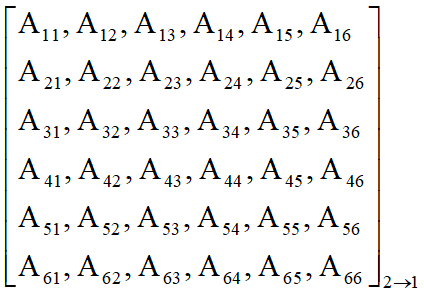
.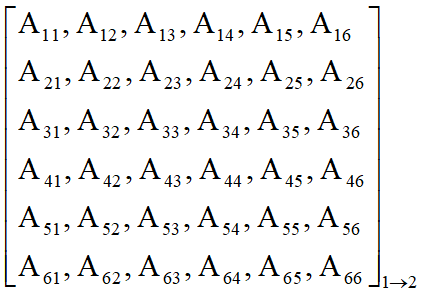
Input: |
Description |
Floating Body 1: |
The name of the first floating body of the coupled pair. |
Floating Body 2: |
The name of the second floating body of the coupled pair. |
Matrices (6x6): |
Two 6x6 matrices of hydrodynamic coupling data. See Note (a). |
(a)Refer to Hydrodynamic Coupling Coefficients for further information on the layout of the hydrodynamic coupling terms.
(b)The type of added mass coupling specified for a particular floating body couple, either Constant or Frequency Dependent, should be consistent with the type of radiation damping coupling specified for the same floating body couple.
To reference frequency dependent and cut-off hydrodynamic coupling matrices for use with adjacent floating bodies.
Line defining the coupled pair of floating bodies:
FLOATING BODY 1=Floating Body Name, FLOATING BODY 2=Floating Body Name
Line defining the type of coupling:
COUPLING=ADDED MASS/RADIATION DAMPING
Input: |
Description |
Floating Body 1: |
The name of the first floating body of the coupled pair. |
Floating Body 2: |
The name of the second floating body of the coupled pair. |
Type: |
This option allows you to specify that the hydrodynamic coupling data relates to Added Mass (the default) or Radiation Damping. |
Frequency Dependent Hydrodynamic Coupling: |
The name of the constant or frequency-dependent hydrodynamic coupling matrix definition. |
Cut-Off Hydrodynamic Coupling: |
The name of the cut-off hydrodynamic coupling matrix definition. |
(a)Any properties which you refer to for a particular floating body couple must be defined in other tables – i.e. Body - Frequency Dependent Hydrodynamic Coupling and Body – Cut-Off Hydrodynamic Coupling.
To define frequency-dependent hydrodynamic coupling for with a floating body couple. The data may relate to Added Mass or Radiation Damping.
Block of lines defining frequency dependent coupling, preceded by a single TYPE=FREQUENCY line:
TYPE=FREQUENCY
FREQ=Frequency
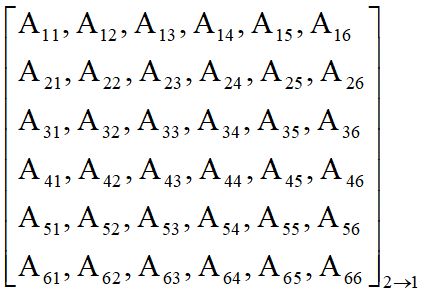
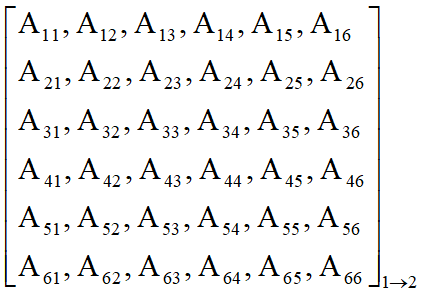
Input: |
Description |
Name: |
The name of the hydrodynamic coupling matrices. |
Frequency: |
The frequency in Hertz to which the 6x6 hydrodynamic coupling matrices relate. |
Matrices (6x6): |
Two 6x6 matrices of hydrodynamic coupling data. See Note (a). |
(a)Refer to Hydrodynamic Coupling Coefficients for further information on the layout of the hydrodynamic coupling terms.
(b)This table is used in conjunction with the Body - Cut-Off Hydrodynamic Coupling table, in which hydrodynamic coupling at the cut-off frequency is specified. Hydrodynamic coupling at the cut-off frequency is completely defined by two 6x6 matrices. The cut-off frequency itself is specified in the Body – Frequency table. You should ensure that both floating bodies in a couple are assigned the same cut-off frequency.
(c)For frequencies below the cut-off frequency, the hydrodynamic coupling corresponds to the hydrodynamic coupling at the cut-off frequency. If no cut-off frequency is specified, the hydrodynamic coupling is assumed to be zero below the range of user-specified frequencies.
(d)For frequencies above the range of user-specified frequencies, the hydrodynamic coupling is assumed to be zero.
(e)For frequencies that do not exactly match one of the frequencies specified, Flexcom linearly interpolates between the nearest frequencies to find the relevant values of hydrodynamic coupling.
(f)You do not need to specify the frequencies in any particular order; ascending order is not necessary.
(g)The type of added mass coupling specified for a particular floating body couple, either Constant or Frequency Dependent, should be consistent with the type of radiation damping coupling specified for the same floating body couple.
To define cut-off hydrodynamic coupling for a floating body couple. The data may relate to Added Mass or Radiation Damping.
Block of lines defining coupling at the cut-off frequency:
TYPE=CUTOFF
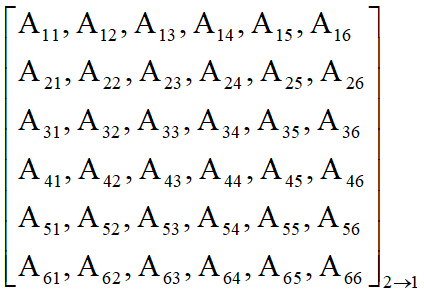

Input: |
Description |
Name: |
The name of the hydrodynamic coupling matrices. |
Matrices (6x6): |
Two 6x6 matrices of hydrodynamic coupling data. See Note (a). |
(a)Refer to Hydrodynamic Coupling Coefficients for further information on the layout of the hydrodynamic coupling terms.
(b)This table is used in conjunction with the Body - Frequency Dependent Hydrodynamic Coupling table, in which frequency-dependent hydrodynamic coupling is specified. The cut-off frequency itself is specified in the Body – Frequency table. You should ensure that both floating bodies in a couple are assigned the same cut-off frequency.
(c)For frequencies below the cut-off frequency, the hydrodynamic coupling corresponds to the hydrodynamic coupling at the cut-off frequency. If no cut-off frequency is specified, the added mass is assumed to be zero below the range of user-specified frequencies.